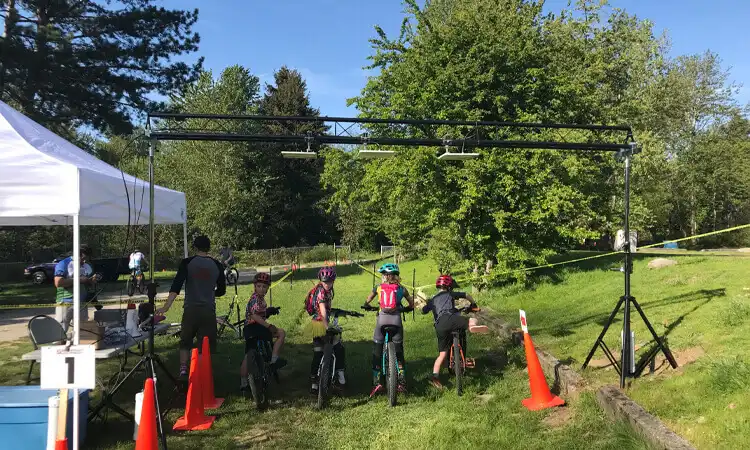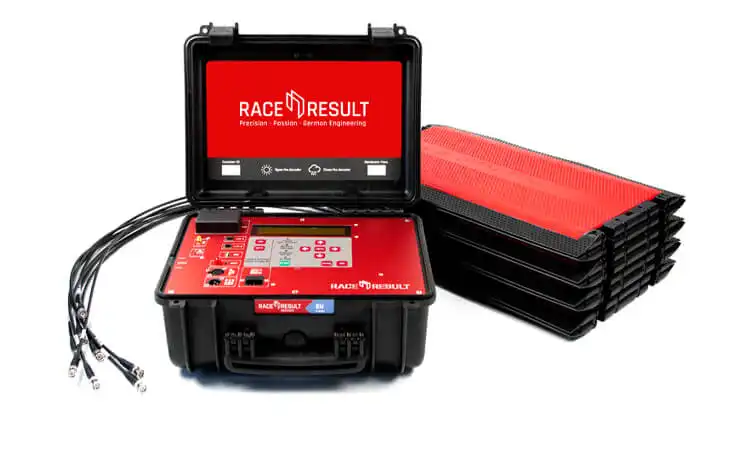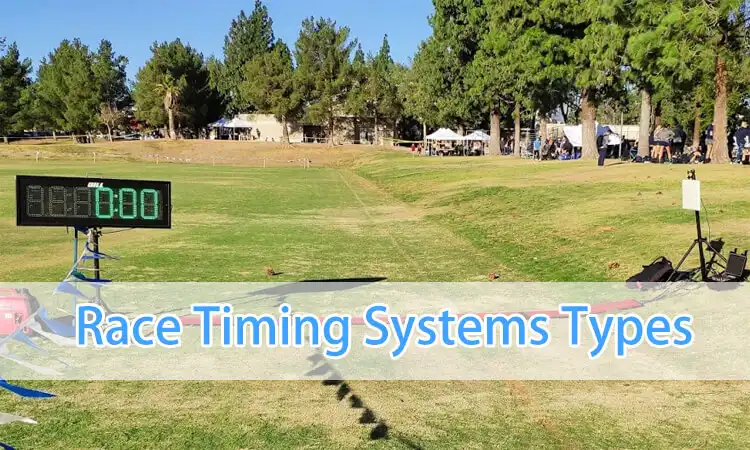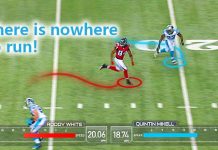When considering purchasing or building an RFID race timing system, the software is one of the most critical factors. There are two primary options to consider: writing your own software or purchasing an out-of-the-box software solution. The type of hardware and tags used with your system will depend significantly on the software option you choose. Understanding the pros and cons of each method will help you make an informed decision on purchasing or building an RFID race timing system.
What is Race Timing System?
A chip timing system is used for accurately timing race events, such as running, triathlons, and road cycling races. It typically consists of the following components:
- Timing chips – Participants wear small timing chips, usually attached to their shoelaces or bib numbers. The chip contains an RFID tag or transponder.
- Timing mats – The mats are placed at the start line, any intermediate timing points, and the finish line. They detect the timing chips as athletes cross over them.
- Timing system hardware – This includes cables to connect the mats, RFID/transponder readers to detect the chips, and computers to record the timing data.
- Timing system software – The software records and processes the timing data detected by the hardware. It calculates each participant’s finish times, splits, rank order, etc.
- Additional equipment – Depending on specific requirements, such as start triggers, loop detectors, aerial antennas, etc., may also be included.
What Types of Race Timing Systems are Available?
In general, there are two types of RFID race timing systems to consider: DIY and Out-of-the-Box Software. DIY systems involve developing custom software to meet the specific needs of your race event, while Out-of-the-Box Software provides pre-built software solutions for race timing. Out-of-the-Box Software can be subdivided into three types: One-Time Fixed Cost, Pay-As-You-Go, and Contract Systems. Each option has its own set of benefits and drawbacks that should be carefully weighed before making a decision.
Should I Choose DIY or Out-Of-The-Box?
You must consider several factors when deciding between a DIY or an Out-of-the-Box RFID race timing system. These include upfront costs, variable costs, upfront RFID knowledge needed, flexibility, and ongoing support.
Upfront costs for an RFID race timing system are usually defined by the costs of purchasing the initial system. Still, ongoing costs like licensing fees and disposable RFID tag costs are not included. Some systems have high upfront costs but low variable costs, while others have low, upfront costs but high variable costs.
Upfront RFID knowledge needed refers to the amount of RFID background and knowledge the buyer should have before purchasing the system. DIY systems require the buyer to have working knowledge of RFID or be willing to invest time and effort to learn how to create the software and system. On the other hand, Out-of-the-Box solutions provide pre-built software and hardware that require less technical knowledge.
Flexibility is another important consideration when choosing an RFID race timing system. The general level of flexibility is determined by the race timer’s ability to adjust the system in response to race changes, environmental changes, or preference changes. DIY systems are generally the most flexible because the race timer can build a custom software and hardware system that fits their needs. Out-of-the-Box solutions may offer some level of customization, but they may not be as flexible as DIY systems.
Variable costs are ongoing costs associated with using the RFID race timing system, such as licensing fees, disposable RFID tag costs, and replacement equipment. Some systems have low variable costs but high upfront costs, while others have high variable costs but low, upfront costs.
Finally, ongoing support is critical when choosing an RFID race timing system. Most Race Timing Systems include hardware support, as RFID readers typically come with manufacturer support. Out-of-the-Box systems typically offer software support as well, with varying levels of ongoing support depending on the type of system. DIY systems may require more effort to maintain and troubleshoot, but the race timer has more control over the system and can make modifications as needed.
Do-It-Yourself (DIY) Race Timing Systems
A Do-It-Yourself (DIY) RFID, race timing system involves developing custom software to meet the specific needs of the race event. DIY systems allow customization of the software and hardware components to achieve optimal performance. This makes them a popular choice for experienced race-timers with technical knowledge.

One of the main challenges of a DIY system is the extensive knowledge of RFID and the software required to build and maintain the system. The race timer must have expertise in both hardware and software to ensure that the system operates smoothly. Although DIY systems typically have a lower upfront cost than Out-of-the-Box solutions, the cost of coding and creating software or hiring a software engineer to complete the system can add to the overall cost.
One of the significant advantages of a DIY system is the flexibility to change the system based on additional needs. If there is a change in the read zone width or height due to environmental changes, DIY systems can add or subtract hardware components to provide the required coverage for the new course. This flexibility, both in the amount and type of hardware, makes this type of system very popular.
Furthermore, software design can provide substantial functionality and flexibility, such as incorporating cameras or building custom API integrations to other software systems. In the long run, a DIY system can have low variable (per runner) costs because you can purchase tags on the open market and avoid software licensing fees. Thus, in high volumes, a DIY race timing system can be economical and provide the race timer with complete control over the system.
Out-Of-The-Box Race Timing Systems
Out-of-the-Box Race Timing Systems are pre-built solutions that include software and hardware components designed for race timing. These systems are typically developed by software companies specializing in race timing technology. And they are designed to be easy to use and require minimal technical expertise.

Out-of-the-Box systems typically include RFID readers, antennas, cables, and tags designed to work together seamlessly. The pre-built software may include real-time tracking, integrated video or photo capture, and automated result generation. Out-of-the-Box Race Timing Systems can be divided into three main variations based on their pay structure: One-Time Fixed Cost Systems, Pay-As-You-Go Systems, and Contract Systems.
One-Time Fixed Cost Systems
One-Time Fixed Cost systems are pre-built race timing solutions that require a one-time payment upfront. It provides the buyer with the software and hardware necessary to run the system. Many Race Timing Systems are hardware-agnostic, which means that the buyer purchases software rights that can work with a variety of RFID hardware options. Specifically, the software communicates with the RFID reader using Low-Level Reader Protocol (LLRP), which enables them to work with most enterprise-level RFID readers.
One-Time Fixed Cost systems cater to race timers with the technical expertise to source and configure their RFID hardware and tags. These systems provide complete ownership and control over the race timing process. This includes the ability to customize the hardware components to suit the specific needs of the race event. Once these systems are purchased, no ongoing software costs or licensing fees exist. And the only variable cost is likely to be the cost per tag (if disposable tags are used).
One of the primary advantages of One-Time Fixed Cost systems is their flexibility. The buyer has complete control over the choice of RFID hardware and tags, which can help to ensure that the system operates seamlessly. Additionally, these systems offer complete ownership and control over the entire race timing process, including the ability to troubleshoot and maintain the system in-house.
However, One-Time Fixed Cost systems may require more technical expertise than Out-of-the-Box systems. The buyer is responsible for sourcing and configuring the RFID hardware, which may require additional time and effort. Additionally, a learning curve may be associated with effectively using the software and hardware components.
Overall, One-Time Fixed Cost systems can be an economical and flexible option for race timers with the technical knowledge and resources to source and configure their RFID hardware. These systems provide complete ownership and control over the race timing process without the ongoing software costs or licensing fees associated with other race timing solutions. However, race timers who do not have the technical expertise to configure their own hardware may find other race timing solutions more suitable for their needs.
Pay-As-You-Go System
Pay-As-You-Go Systems are race timing solutions that charge a fee for each race timed. It provides a flexible option for race-timers who do not want to commit to a one-time payment upfront or an annual services contract. These systems may or may not include RFID hardware, with some companies offering complete systems that include hardware, while others allow customers to choose their own hardware.
One advantage of Pay-As-You-Go Systems is the ability to scale up or down as needed. Race timers can choose to time a single event or multiple events without committing to a long-term contract. Additionally, these systems may provide a more cost-effective option for race-timers who do not have the resources to purchase a One-Time Fixed Cost System upfront.
Another advantage of Pay-As-You-Go Systems is the ongoing support and improvements provided by the software company. These systems typically offer more advanced features than other race timing solutions, such as real-time tracking and integrated photo or video capture. The software company is incentivized to continually improve its products and provide ongoing support to ensure customer satisfaction.
However, Pay-As-You-Go Systems may have higher variable costs than other race timing solutions, as the buyer is charged a fee for each race timed. Additionally, race-timers who use these systems may have less control over the hardware components, as the software company may have specific hardware requirements or limitations.
Race timers should carefully evaluate the variable costs associated with these systems and the hardware requirements and limitations. Pay-As-You-Go Systems may not be the most cost-effective option for race-timers who time many events yearly, as the variable costs may increase quickly. Additionally, race-timers who require specific hardware components may find that these systems do not offer the necessary flexibility to meet their needs.
Contract System
Contract Systems are full-service race timing solutions requiring a contractual agreement between the race timer and the company. These systems offer comprehensive training and ongoing support and typically require the use of tags and hardware purchased directly from the race timing company. As a result, both fixed and variable costs for this option may be high.
Contract Systems are particularly well-suited for “high-stakes” races where the highest precision and accuracy are required. These races may involve professional runners or significant cash prizes, and Contract Systems offer the most comprehensive support and services to ensure that the race is timed flawlessly.
One advantage of Contract Systems is the race timing company’s level of support and expertise. These systems typically offer the most advanced features and technology, ensuring that the race is timed with the highest level of accuracy and precision. Additionally, race timers can access ongoing support and training, ensuring the system operates seamlessly.
However, Contract Systems may not be the most cost-effective option for race timers who do not require the highest level of precision. These systems’ fixed and variable costs may be prohibitive for smaller or less high-profile races. Additionally, race timers who prefer to use their own RFID hardware and tags may find that Contract Systems do not offer the necessary flexibility to meet their needs.
Where can Buy Chip Timing System?
If you want to purchase a chip timing system, a good place to start is to check out the online catalog of available systems. You can read reviews from other race directors and professional timekeepers there to help you make an informed decision.
About Timing Software Explanations
Regarding timing software, some chip timing systems come with software from the manufacturer, while others offer their own software at an additional cost. Alternatively, you can use third-party timing software compatible with most systems.
Pros and Cons of Buying
There are pros and cons to buying a pre-assembled chip timing system. Plus, it’s a no-fuss solution that’s easy to deploy on race day, and manufacturers typically offer support. However, you may face higher ongoing costs if you need to purchase coded tags or pay to “unlock” your system. Additionally, it may be challenging to upgrade or replace faulty components.
Chip Timing System Rental
Chip timing system rentals provide the equipment and service for temporarily using a chip timing system for an event. This reduces the upfront costs for event organizers. The rental package typically includes:
- Delivery and setup of all the timing equipment before the event.
- Proper functioning of the equipment during the event. The technical support staff will be on-site to address any issues.
- Packup and removal of all equipment after the event conclusion.
- Event results – The timing data and results analysis are provided to the event organizers after the event.
- Liability – The timing equipment and support are provided by an experienced company, reducing risks and liabilities for the event organizers.
Why Renting Makes Sense?
Renting provides accurate and reliable timing without a significant investment. A rental system is customizable, and rental companies offer experienced support.
Where can I Rent a Timing System?
For events needing a chip timing system, renting is often a good and affordable option. Chip timing system rentals allow you access to professional equipment without high upfront costs or long-term commitments.
In the UK, you can rent timing systems from:
- Race Timing Solutions – Official UK reseller for Macsha timing systems. They Offer Macsha rentals.
- Event Race Timing – Also rents RACE RESULT timing systems with options to integrate GPS race tracking.
In the US, reliable options for renting chip timing systems include:
- RaceTime – Official US distributor for Macsha timing equipment. They rent Macsha timing systems.
- RACE RESULT – Rents RACE RESULT timing systems through their website.
The key benefits of renting a chip timing system are:
- No long-term commitment: Try out different systems before purchasing.
- Replacement guarantee: Rent the latest technology and promptly replace faulty equipment.
- Expert support: Vendors often provide good support for their rented equipment.
While renting avoids high upfront costs, the overall costs can be high if used continually for a long period of time. Outside support may also be limited compared to purchasing a system and hiring a timing company.
In summary, renting a high-quality chip timing system provides an affordable and low-risk option for many smaller events or those wanting to try out different equipment. Purchasing may save money for larger, repeat events despite the higher initial outlay.
Race timing systems are essential for accurately recording race results. Selecting the right timing solution depends on the precision, flexibility, and budget required for your event. One-Time Fixed Cost, Pay-As-You-Go, and Contract Systems offer different benefits and limitations. You should carefully evaluate their specific needs and associated costs before choosing a race timing solution to ensure a flawless race experience.
Related Reading: RFID Timing Chip for Cycling, Motocross, and Marathons Races
About Race Timing Systems Problem
-
What are Race Timing Systems, and how do they work?
Race Timing Systems are systems used to accurately time and track participants in a race event. They typically use RFID tags and readers to record the participants’ times at various points throughout the race.
-
What factors should I consider when choosing a Race Timing System?
When choosing a Race Timing System, it’s important to consider factors such as the level of precision required, the number of participants, the available budget, and the level of support and training the system offers.
-
What are the different types of Race Timing Systems, and what are their benefits and limitations?
There are three main types of Race Timing Systems: One-Time Fixed Cost Systems, Pay-As-You-Go Systems, and Contract Systems. Each system offers different benefits and limitations, such as flexibility, scalability, and cost-effectiveness.
-
How do One-Time Fixed Cost Race Timing Systems differ from Pay-As-You-Go Systems?
One-Time Fixed Cost Race Timing Systems require an upfront payment and provide ownership and control over the timing process. Pay-As-You-Go Systems charge a fee for each race timed, providing flexibility and scalability.
-
What are the advantages and disadvantages of using a Pay-As-You-Go Race Timing System?
Pay-As-You-Go Race Timing Systems offer cost-effectiveness and scalability but may have higher variable costs for each race timed.
-
What is a Contract Race Timing System, and when might it be best?
Contract Race Timing Systems require a contractual agreement between the race timer and the race timing company and provide the highest precision and support. They may not be the most cost-effective option for smaller or less high-profile races.
-
How do Race Timing Systems impact the overall race experience for participants?
Race Timing Systems play a crucial role in the overall race experience for participants. It provides accurate and reliable timing information, allowing participants to track their progress and compete.
-
What is the cost of implementing a Race Timing System, and how can I ensure it fits within my budget?
The cost of implementing a Race Timing System varies depending on the type of system chosen and the level of support and training required. You must carefully evaluate each system’s costs and benefits before ensuring it fits within the available budget.











